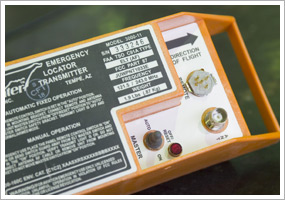Custom content from the Jan. 21, 2011, issue of 'AOPA ePilot' newsletter
| The following stories from the Jan. 21, 2011, edition of AOPA ePilot were provided to AOPA members who expressed an interest in the particular subject areas. Any AOPA member can receive information tailored to their areas of interest by updating their preferences online. |
training tipsChecking your ELT How do pilots help ATC check for an ELT signal? By tuning their communications radio to the emergency frequency 121.5 MHz and listening for the telltale beeping tone. Many airliners and military aircraft tune a spare radio to the “guard” frequency. It’s also monitored at ATC facilities. Where is your trainer’s ELT installed? What are its maintenance requirements? ELTs only function properly if the battery is sufficiently charged. The federal aviation regulations address this requirement. This sample question from the private pilot knowledge test checks your knowledge of it: When must the battery in an emergency locator transmitter (ELT) be replaced (or recharged if the battery is rechargeable)? Ask your aviation mechanic to show you the ELT and explain how to turn it off after accidental activation. Being better informed on ELTs would have helped one pilot quiet his unit promptly, as he shared in the March 2007 Flight Training feature “ Unwanted beeping.” Make it a habit to check 121.5 MHz before you shut down your engine to ensure that your ELT was not activated by that less-than-perfect landing. You may have read that ELTs transmitting on 121.5 MHz might soon disappear from the scene. That is no longer the case, as AOPA reported on Jan. 13. The answer to the sample test question is found on page 8-9 of the Pilot’s Handbook of Aeronautical Knowledge : “Batteries used in the ELTs must be replaced (or recharged, if the batteries are rechargeable): When the transmitter has been in use for more than 1 cumulative hour. When 50 percent of the battery useful life (or, for rechargeable batteries, 50 percent of useful life of the charge) has expired. An expiration date for replacing (or recharging) the battery must be legibly marked on the outside of the transmitter and entered in the aircraft maintenance record.” training products‘You Can Be a Pilot!’ by Chris FindleyAre you thinking of learning to fly, or do you know someone who’s been curious about it? Take a look at this softcover book, subtitled Answers to 25 Popular Questions about Learning to Fly. Author Chris Findley, a CFI and a frequent contributor to AOPA’s Let’s Go Flying! blog, has created a comprehensive breakdown of flight training requirements in a conveniently sized volume. It sells for $12.99 from the author’s website.
Note: Products listed have not been evaluated by ePilot editors unless otherwise noted. AOPA assumes no responsibility for products or services listed or for claims or actions by manufacturers or vendors. final exam
Question: Can I legally fly an aircraft that has known inoperative equipment?
Answer: Unless the flight is conducted under FAR 91.213, the regulations require that all equipment installed on an aircraft in compliance with the operating rules or the airworthiness standards be in operable condition. FAR 91.213 provides some acceptable methods in which an aircraft can be operated with certain nonfunctioning instruments or equipment that are not essential for safe flight. One is the use of a minimum equipment list (MEL), authorized under FAR 91.213(a), and the other is operating without an MEL under FAR 91.213(d). Be cautious, however, because it is sometimes easy to violate the regulation inadvertently. For more on the topic, read the AOPA subject report, Minimum Equipment List and Inoperable Instruments.
Got a question for our technical services staff? E-mail [email protected] or call the Pilot Information Center, 800/872-2672. Don’t forget the online archive of “Final Exam” questions and answers, searchable by keyword or topic. |
 Sometimes while flying you may hear air traffic control ask a pilot to check for an emergency locator transmitter (ELT) signal in the area. Perhaps the ELT went off after a hard landing or was triggered by some other accidental cause. Or it could be the beginning of a real search-and-rescue operation.
Sometimes while flying you may hear air traffic control ask a pilot to check for an emergency locator transmitter (ELT) signal in the area. Perhaps the ELT went off after a hard landing or was triggered by some other accidental cause. Or it could be the beginning of a real search-and-rescue operation.

